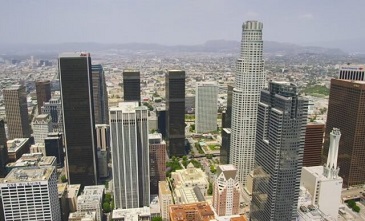 LOS ANGELES—Los Angeles, the nation’s second-largest city, took a bold step toward reducing climate pollution recently when its City Council adopted an amendment aimed at making steep reductions in greenhouse gas (GHG) emissions from commercial and residential buildings, including by transitioning from conventional natural gas to electricity generated from pollution-free sources like wind and solar.
LOS ANGELES—Los Angeles, the nation’s second-largest city, took a bold step toward reducing climate pollution recently when its City Council adopted an amendment aimed at making steep reductions in greenhouse gas (GHG) emissions from commercial and residential buildings, including by transitioning from conventional natural gas to electricity generated from pollution-free sources like wind and solar.
The council approved a resolution that requires the city’s building department and utility to 1) make specific recommendations to reduce building demand for natural gas, and shift gas use to clean (pollution-free) electricity, and 2) establish aggressive 2028 and 2038 building electrification targets that meet or exceed LA’s climate goals, which include reducing GHG emissions by percent before 2035.
Direct emissions from fossil fuel use in California’s buildings (largely from natural gas burned for space and water heating) are on par with emissions from all in-state power plants. And fugitive emissions from production, distribution, and on-site leaks of natural gas add to the climate impacts of natural gas use in buildings. As our electricity supply gets cleaner because we are using pollution-free renewable resources to generate it, these direct fossil fuel emissions from buildings will become one of the top barriers to achieving California’s climate goals—on-site combustion of fossil fuels already account for over 40 percent of climate-warming emissions from buildings in the state.
Los Angeles Leading the Way on GHGs in Buildings
Los Angeles is the largest city in California, and it has the largest municipal electric utility (LADWP, or the Los Angeles Department of Water and Power) in the nation. Los Angeles also has a huge population of lower-income renters living in multifamily apartments—nearly half a million, who will benefit from cleaner indoor air and reduced risks of combustion hazards if natural gas is replaced by clean electricity. This resolution builds on the recent passage of Los Angeles’ Benchmarking Ordinance for evaluating energy and water use in buildings, which is among the most ambitious in the country.
The City Council’s resolution is also poised to galvanize the improvements needed from LADWP’s current energy efficiency program offerings, which provide financial incentives to make upgrades to residential and commercial buildings that reduce utility bills. Smarter energy use also reduces the need to use fossil fuels to generate electricity. While LADWP offers an impressive number of efficiency incentives for buildings, the amount of fragmentation and paperwork required to put together a single project, for example in a low-income multifamily building, currently prevents widespread adoption.
State Action is Needed
It is becoming starkly clear that the leaders of California—like the City of Los Angeles—must take decisive action to significantly reduce GHGs from buildings—or “decarbonize” them—to meet climate commitments and to improve the health of communities.
The building decarbonization priorities for 2018 and beyond include:
- Make building decarbonization a priority in California’s climate strategy. The Golden State’s political leaders need to provide clear direction to state agencies to make decarbonization of the building sector a priority at the same level as removing carbon resources from the electricity grid and transportation.
- Set targets for the electrification of space and water heating in residential and commercial buildings. Like the City of LA, state leaders should launch a public process to evaluate and set targets for electrification in buildings, resulting in a comprehensive and actionable blueprint that can guide implementation and coordination across agencies.
- Remove regulatory barriersto electrification. This includes leveling the playing field for clean electricity in the state’s building energy code, so gas is not preferred over electricity in new buildings.
- Provide alternative funding sources that will help building decarbonization technology such as efficient “heat pump” hot water heaters come down the cost curve, just like solar panels and electric vehicles have thanks to the state’s policies.
The Natural Resources Defense Council (NRDC) is hopeful that the LA City Council’s action will inspire leadership on the part of the state’s governor, legislature, state agencies, and other cities to address the use of fossil fuels in buildings, thereby reducing GHG emissions and improving the air all Californians breathe—both inside their homes and workplaces, and outdoors.
This article was originally published at www.nrdc.org and is reprinted with the permission of the Natural Resources Defense Council (NRDC). Merrian Borgeson is Senior Scientist, Energy program for NRDC. Maria Stamas is Project Attorney, Energy & Climate programs, NRDC.






